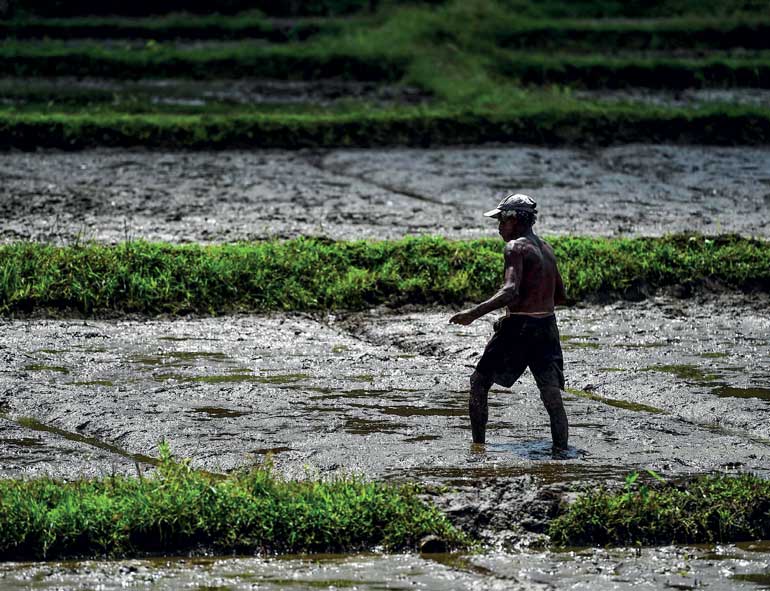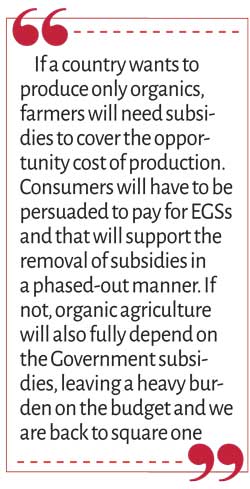Sunday Dec 07, 2025
Sunday Dec 07, 2025
Tuesday, 24 August 2021 03:44 - - {{hitsCtrl.values.hits}}

Introduction
We come from a proud and resilient group of organic farmers. We made our own organic fertiliser and bio-pesticides and were able to manage our crops successfully. However, with increasing population came the need for increasing production. 
When land and other essential resources are limited, the best way to go about was increasing the productivity and efficiency. Hence came the need for improved crop varieties and high efficiency synthetic fertiliser and pesticides. However, overtime, our producers ended up using more synthetic fertilisers and pesticides way beyond the prescribed levels by the Department of Agriculture (DOA). These inefficient uses resulted in environmental pollution, soil and water degradation and even increasing Maximum Residual Levels (MRLs) in food.
Overtime, the fertiliser subsidy became a political tool rather than an economic one. Hence, we ended up creating environmental, health, social and economic externalities within and outside the production system. This was not the sustainable agriculture we wanted. The private sector saw the opportunity in organic agriculture, especially the demand in the international market. With this more specialised but concentrated organic export value chains were created with international certifications. Local certifications and the emergence of supermarkets gave opportunity to local organic value chains.
By early 2020, Sri Lanka was in a steady path of promoting organic agriculture in Sri Lanka with an aim of moving towards 30-40% of its total production under organic agriculture with international and local certifications. Then came the policy decision to go for 100% organic with immediate effect, banning all imports or synthetic fertilisers and pesticides. This policy decision is being debated and discussed in many forums and has basically divided people into groups. Each have their own justifications backed by science as well as experience. The objective of this article is not to start a debate again, but to highlight five key points to consider in implementing a successful organic agriculture program in Sri Lanka.
Understanding the incentives and opportunity costs for organics is important
Organic agriculture is a closed production system. Ideally all inputs need to come within the system. If anything is brought from outside, it has to be certified as organic. Usually, organic agriculture is focused on specialised value chains backed by a certification. These certifications are audited annually. Heavy penalties are involved if protocols are broken. There is an opportunity cost involved in producing organic products; usually these come from land, labour, technology, inputs and market linkages. 
Hence from an economic perspective, we need to ask the question, “For a farmer to produce same level of output or earn same level of profits, what additional costs will he have to incur when going into organic farming?” Farmers who had the ability to match the opportunity cost of production with the consumers’ willingness to pay (WTP) thrived in organic production while others failed. However, most organic producers identify the ‘price’ as their main incentive to go for organic farming. The rest of the incentives covered in connection to ‘Ecosystem Goods and Services’ (EGSs) are secondary to them.
Yet understating the full range of opportunity costs and incentives (both private and social) is important to scale up organic agriculture. For example, producers need to ask (1) do I have enough land to do this, which I can certify as organics in a shorter period or time (2) do I have all the inputs in my farm, what can I make within and what needs to come from outside, do I have certified sources to find what I need from outside (3) do I have enough labour, machinery, technology and investments and (4) do I have a guaranteed market. Hence any organic program will need to provide clear answers to above questions and overtime farmers will become interested on social incentives or EGSs as well.
Can everything be produced organically for the respective target markets?
Simple answer is ‘No’. But let me elaborate. Crops can be produced organically. However, the question is whether it can be produced organically to the required quality grades that attracts the market for it. What we have to accept is that, most farmers became over users of synthetic fertiliser and pesticides to maintain these quality grades that attracted the prices for their produce. Comparing the prices and quality grades at a supermarket and ‘Sunday Fair’ will allow anyone to understand this easily. Hence when going for organic, both farmers and consumers will have to accept this fact.
This is also one of the major reasons for organic produce to end up in a value-added form compared to fresh form. Does that mean organic produce will never reach the quality grades required by the market? Not at all. There are many organic fruit, vegetable and spice producers in Sri Lanka who have pioneered their production programs to achieve the same quality parameters met by inorganically produced ones. But they will tell you how hard it was to reach that level. These producers had gone through a rigorous phase of trial and error at their own cost to reach this level.
However, some crops, especially done under aeroponic and hydroponic systems will have no choice but to depend on synthetic fertiliser and pesticides. Organic substitutes are either not available or too costly. Therefore, any organic program will have to have a prioritisation in terms what crops can be done organically and inorganically. We will have to consider the availability of inputs, costs, market demand and then devise a progression plan accordingly.
Climate change is one of the biggest constraints for agriculture. Weather changes are forcing us to think new ways to protect agriculture from the adverse impacts. While traditional agriculture has shown resilience against impacts of climate change, these practices are with lower production efficiencies. For example, traditional rice growing under organic agriculture systems have more resilient to climate change impacts. But the question is whether the production is enough to establish rice food security. While protected and precision agriculture are one of the best ways to overcome climate impacts, how that can operate under a fully organic system needs evidence.
How can we mobilise our traditional knowledge and village experiences?
Anyone who have worked with organic farmers in the country knows the depth of knowledge they have. They may not know the theories of organic agriculture but they have generations of knowledge in doing this correctly. They know that the most important thing in organic agriculture is the ‘soil’! They plan everything around improving and taking care of the soil. They know once the soil is protected and improved it has all the trickle-down effects of water purification, micro and macro-organism density in the soil, toxin free produce and increased bio-diversity. This is what modern science and economics identify as EGSs.
Now the question is how you mobilise this knowledge and experience in to value chains. Department of Agriculture and its provincial departments have good linkages with organic farmers in the area. In fact, most provincial councils have annual competitions and audits and acknowledge and give awards to these farmers. Some even appear in newspapers, highlighting the best practices that these farmers do.
These farmers can be found in all Divisional Secretary (DS) divisions of the country. It’s a matter of getting them organised and sharing their experience and knowledge. Many agri-processors, supermarkets, community-based organisations and farmer producer organisations also have close contacts with these farmers. Even agricultural consultants who work in organic agriculture have close contacts with these farmers. Hence, it’s a matter or coordination and mobilisation. These farmers are the ‘champions’ of organic farming.
Most of them have their own ways of making organic fertiliser (both liquid and solid), compost and other bio-pesticides.
Ingredients for these are area specific but the concept behind and the process is same. What you can find as N sources and insect repellents will vary between down south and hill country. This very nature has an impact on large scale availability of common organic fertilisers and bio-pesticides. Hence the input scarcity calls for the need of area specific organic fertilisers and bio-pesticides. In terms of scaling up, production facilities at DS division level can be established. All necessary inputs can be concentrated in to this facility, giving employment opportunities to locals.
An entrepreneur or a group or entrepreneurs in the DS division itself can drive this as a profitmaking centre. Many such models are there in agricultural value chains and they can be easily adapted. However, one should also understand the lower efficiencies in this sort of a production. This is because it is not tested scientifically to identify the exact nutrient composition it produces. Therefore, giving a recommendation in terms of how much to apply at what frequency is a limitation.
However, this limitation can be overcome by allowing the private sector to come up with organic fertilisers and bio-pesticides. They have the technical, capital and human resources to make efficient organic fertilisers and bio-pesticides, do the field trials and make scientific recommendations on applications.
While organic fertiliser and bio-pesticides by local entrepreneurs can be used by farmers who are interested in local markets, high efficiency (and costly) ones made by private companies can be adapted by farmers in to export and supermarket value chains. This is not something new, it’s a matter of scaling up. Information and communication technology (ICT) can play a bigger role in this.
What is role of the consumer?
Organic venture will not make profits and be sustainable unless consumers are willing to purchase at a price where opportunity cost of production is covered. This is why most farmers who want to come to organic production go out of the value chain within a short period or time. They have to invest several years to be certified as organics, and if the market is not guaranteed then the opportunity cost further increases and the business sustainability is at risk.
Therefore, most companies that focus on organic processed foods work with forward contracts, they even take care of the certification cost of the farmer. Now imagine a situation where organic production or the supply side is increased rapidly. If consumers’ willingness to pay does not match the price, farmer can move away from the value chain. But he can still produce inorganically and sell. Consumer also has the option to buy inorganic.
Now assume a situation where farmer has no option other than to produce organic since synthetic fertiliser and pesticides are not available in the market. Here, farmer does not have the competitive advantage since everyone does a homogeneous product (only organic). Here the consumer will also have no option other than to buy organics. In such a situation the long terms prices of organics will come down compared to a market situation of both organics and inorganics.
In a homogeneous market, ‘organic’ will not yield a price premium. If you follow the article so far, you will note that the ‘price’ is the main incentive for the farmer. This is now lost to him. In such a situation the farmer will demand subsidies to cover the opportunity costs. The only way to convince a consumer to pay a premium for organics will now be the EGSs. The message here is, if a country wants to produce only organics, farmers will need subsidies to cover the opportunity cost of production. Consumers will have to be persuaded to pay for EGSs and that will support the removal of subsidies in a phased-out manner. If not, organic agriculture will also fully depend on the Government subsidies, leaving a heavy burden on the budget and we are back to square one.
A policy framework is essential
Many attempts to formulate an agriculture policy for Sri Lanka is evident throughout history. Successive governments came up with many drafts spending money and human resources. If you look at the recent past, an Overarching Agriculture Policy (OAP) was formulated by the European Union, under its project Technical Assistance to the Modernisation of Agriculture project (TAMAP). This was however not adapted by the Ministry of Agriculture even after many rounds of revisions and alignments to other national policies.
Very recently, with the newly elected Government, another National Agriculture Policy (NAP) was formulated. Then came the policy decision to go for 100% organic with immediate effect. Both OAP and NAP contain policy actions and directives for organic agriculture. However, their focus is on a phased out, step by step transition to go for a mix of organic and inorganic production.
A 100% organic attempt will have significant impacts on many sectors of agriculture. Some of these impacts are not studies at all. Limited field experience is not enough to formulate evidence-based policy actions. Hence integrating the policy action on 100% organics into the existing draft agriculture policy needs another set of consultations.
An ideal approach should have been the following steps: (1) Revise the standing draft agriculture policy with the new policy directive of 100% organic (2) get it properly evaluated by all the stakeholders, including public comments (3) gathering necessary evidences or conducting research to suggest strategies and activities and finally (4) getting it approved at least for the next 10-15 years.
However, we are at limbo at the moment. What we have are many draft agricultures polices and a single policy decision to go for 100% organics with immediate effect. We do not have an agreed road map to implement. Though a national committee is established to overlook this policy decision who does what is not clear to the general public. Both the private sector and organisations such as the Lanka Organic Agriculture Movement (LOAM) is doing their best to suggest and recommend policy actions to go for a sustainable transition to organic agriculture. This needs to be applauded.
Way forward
Going for a 100% organic transition is a mammoth task. Doing this with immediate effect is not possible and all evidences support that. What has to happen is a step-by-step transition. Understanding the incentives, prioritising activities and mobilising and coordinating all available resources is necessary. We need to protect our farmer, do just for the consumer, establish food security and also make organic transition sustainable. Always ask the questions: “If organic agriculture is the best, then why is it not done by everyone?”. Answers to this will guide you to make a smooth and effective transition.
(The writer is an agriculture economist and the founder of Green Space Consultancies. He can be reached at 0770210777, [email protected].)